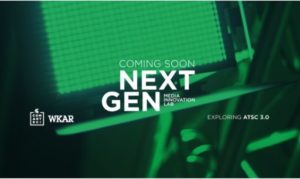- About
- Members
- Sponsors
- Subcommittees
- Technical Documents
- News
- Events
- Spotlight ATSC 3.0
- Contact Us
- Member Login
- Member Meetings
- Advanced Search
Search Site
Member Links
- About
- Members
- Sponsors
- Subcommittees
- Technical Documents
- News
- Events
- Spotlight ATSC 3.0
- Contact Us
- Member Login
- Member Meetings
- Advanced Search
GO SPARTANS! Road to ATSC 3.0 – Michigan State Public Television
Posted on March 4, 2019 in ATSC News
WKAR at Michigan State University in East Lansing is one of the leading public television stations taking an active role in ATSC 3.0 – currently operating with a Next Gen TV signal on channel 35. Their focus is on maximizing the potential of Next Gen TV to increase access to content among rural and low-income households with limited access to internet.
“Both our WKAR team, under [WRAR General Manager] Susi Elkins’ leadership, and our faculty have been intrigued by the possibilities of ATSC 3.0 for education, health, local news and outcomes that will benefit the public. And our engineers were interested in experimenting with the spectrum related to things like autonomous vehicles,” said Prabu David, Michigan State University Dean of the College of Communication Arts and Sciences.
Using Curious Crew, a children’s science program produced by WKAR-TV, the station is offering supplemental content to the hundreds of thousands of Michigan families without a broadband connection. With ATSC 3.0, WKAR wants to bundle supplemental content via the broadcast. Currently, WKAR is offering Curiosity Guides, tutorials and other content through the WKAR-TV website. They hope to demonstrate Curious Crew in the lab this month using a modified gateway device, in partnership with Triveni Digital.
“Our main goal has been to examine the use of ATSC 3.0 for outcomes such as education and emergency alerting, which are critical for public TV stations,” said David. “We have already distributed PBS Playtime Pads to kindergarteners in the Lansing School District, which will serve as a platform to test the companion screen application. And MSU has launched a major initiative on mobility, including autonomous vehicles. We are in the early stages of exploring potential applications of ATSC 3.0 in this new and exciting area.”
Launching the new standard at Michigan State has been a collective effort. David notes the support of field service engineers from Hitachi/Comark, Enesys, Ateme and Triveni who came on site during the station build out. Having this collaboration meant there were no major difficulties in activating the ATSC 3.0 signal.
WKAR also received dongle receivers from Korea-based LowaSis. After testing and a software upgrade, the station was able to receive and decode all four of its program streams, provided the transmission was in Korean mode instead of U.S. mode, David explained. Additional software upgrades now allow WKAR to enable reception in U.S. mode. “Our engineering team enjoyed this process and learned much,” he added.
Next in the experimental phase at WKAR is examining the potential of ATSC 3.0 to serve content on mobile devices, such as smartphones, tablets or IoT devices. A key research effort in the lab is the optimal design of programming for a variety of mobile and companion devices. In keeping with this theme of mobility they are actively exploring its potential in autonomous vehicles.
 “ATSC 3.0 is talked about in highly technical terms. However, serving our local community better is really the biggest benefit it affords, so we thought we should experiment first with content that is distinctly local. We’re excited to explore all the ways we can tailor programming using the capabilities of ATSC 3.0 to meet the unique needs of our viewers,” said David.
“ATSC 3.0 is talked about in highly technical terms. However, serving our local community better is really the biggest benefit it affords, so we thought we should experiment first with content that is distinctly local. We’re excited to explore all the ways we can tailor programming using the capabilities of ATSC 3.0 to meet the unique needs of our viewers,” said David.
Posted in ATSC News
News Categories
News Archives
Subscribe
Subscribe to The Standard, our monthly newsletter. Learn More
Join ATSC
ATSC is a membership organization with both voting and observer categories. Voting members include corporations, nonprofit organizations, and government entities, and they participate actively in the work of ATSC. Observers are individuals or entities not eligible to be a voting member.
Subscribe to our Newsletter
Subscribe to The Standard, our monthly newsletter, to stay up-to-date with ATSC news and events around the world.
Site Links
Contact Us
Advanced Television Systems Committee, Inc.
1300 I Street NW, Suite 400E
Washington, DC 20005
Do you have questions about ATSC?
About ATSC
The Advanced Television Systems Committee, Inc., is an international, non-profit organization developing voluntary standards and recommended practices for digital terrestrial broadcasting. ATSC member organizations represent the broadcast, broadcast equipment, motion picture, consumer electronics, computer, cable, satellite, and semiconductor industries. ATSC also develops digital terrestrial broadcasting implementation strategies and supports educational activities on ATSC standards.
© 2025 ATSC






































